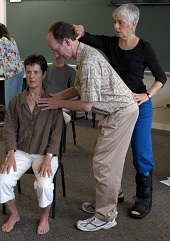 Lessons in the Alexander Technique involve developing self observation under the guidance of a teacher, who gives both verbal and tactile prompts, in order to help acquire skills designed to improve refined coordination patterns.
Lessons in the Alexander Technique involve developing self observation under the guidance of a teacher, who gives both verbal and tactile prompts, in order to help acquire skills designed to improve refined coordination patterns.
“Carol Boggs is a marvelous coach, an intuitive teacher and a skilled ‘listener.’ She has helped me find release, flow and freedom of movement in spite of my ongoing struggle with arthritic knees.
Carol is ‘the best’!!!”
– Nancy Havlik, dancer/choreographer
Typically lessons are for one hour. Please call 301 681 8318 or email carol.s.boggs@gmail.com to schedule an appointment.
Chair Work:
Most adults have lost the ease of a toddler’s bending, reverting to bending the spine as though it were hinged midway rather than coordinating hips and knees. Sitting down and standing up from a chair are common actions within a lesson. These actions highlight basic bending coordinations that are essential in everyday life. Well coordinated bending is essential to many everyday activities including: teeth brushing, bed making, dishwasher unloading, sitting and standing, picking up objects from the floor, etc. Once seated, bending forward to the desk, writing, using a computer, eating, and reading are all tasks that can benefit from improved use of the body.

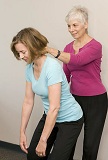

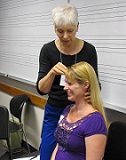
Table Work:
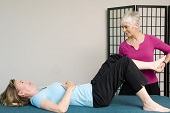 Lying on the table gives the student the opportunity to utilize gravity for undoing unnecessarily held tensions that are carried into the horizontal from being vertically upright, as well as priming the nervous system with specific spatial intentions to facilitate better upright support. The self care at-home version of this work is variously called Lying Down Work, Active Rest, or Semi-supine.
Lying on the table gives the student the opportunity to utilize gravity for undoing unnecessarily held tensions that are carried into the horizontal from being vertically upright, as well as priming the nervous system with specific spatial intentions to facilitate better upright support. The self care at-home version of this work is variously called Lying Down Work, Active Rest, or Semi-supine.
Listen to an Active Rest Talk-through below, or click here for the downloadable mp3.
Thinking in Activity
Putting the Alexander Technique into practice involves being mindful in activity. At first it seems to take a large part of one’s attention to be mindful and wake up to applying newly acquired skills. Much like learning a language, the more you use the skills, the more fluent you get. As skills get integrated, and as quickly and easily as you can have an idea, you can help yourself.
Any activity can benefit from applying the Alexander Technique. Raking leaves, walking, planting a garden, playing tennis, jogging, golfing, working out at the gym, and all of the performing arts (dancing, acting, playing a musical instrument, and singing), not to mention the fine arts (drawing, painting, and sculpting)…any activity that humans do will be enhanced by eliminating extraneous work and overuse, while at the same time supplying sufficient and well coordinated support.
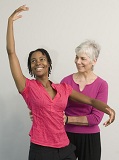
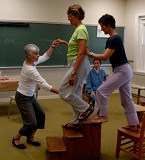

The learning process is different for each individual. Some students learn quickly, integrating and retaining their newfound skills with only a few lessons. Others take more time for the development of kinesthetic awareness clarity of thought, and need more repetition in order to have the confidence to put their new skills into practice.
Photographs by Gail Trost: (from left to right) 2nd Chair Work photograph, Table Work photograph, 1st and 3rd Thinking in Activity photographs.
